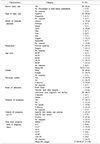Abstract
Background
Scabies is a skin disease caused by Sarcoptesscabiei var. hominis and is transmitted through skin contact. In Korea, its prevalence has decreased since 1990 to approximately <1%. However, recently, the number of patients with scabies has been increasing.
Methods
In this study, 70 hospitals with ≥100 beds and an infection control department were selected by convenient sampling. This study was a cross-sectional survey using a retrospective self-report questionnaire. We surveyed the yearly frequency of scabies infections at the selected hospitals from January 1, 2009, to April 30, 2014. The characteristics and infection controls of cases in the latest outbreaks were documented.
Results
The mean number of beds was 607.8. Of the surveyed hospitals, 44% performed screening for scabies on admission. There were 43 (86.0%) hospitals in which an occurrence of scabies (outpatients, inpatients, staff) was reported at the infection control department during the sampling period, and the yearly percentage increased steadily. Thirty hospitals (60.0%) experienced a scabies outbreak, and the mean age of patients during the scabies outbreak was 70.2 years. Accordingly, 66.7% of the patients were admitted through long-term care facilities. Among the patients with scabies, 47.0% had pruritus on admission, and the mean period until the diagnosis of scabies was 27.3 (1-150) days. At the outbreak of scabies, 64.5% of patients were isolated to a single room. In addition, gowns (83.9%) and gloves (90.3%) were implemented, and used linens were placed in a plastic bag and the bag was sealed airtight, labeled, and disposed separately (86.6%). In 67.7% of the patients, environmental disinfection was conducted in the same way as that for other (non-outbreak) patients' rooms.
Conclusion
It is necessary for each hospital to prepare a scabies screening system that is fit to be used on patients at their admission in order to control the outbreak of scabies. In the future, additional surveys will need to be conducted to identify control measures for scabies infection in long-term care facilities.
Figures and Tables
References
1. Lee WK, Cho BK. Taxonomical approach to scabies mites of human and animals and their prevalence in Korea. Korean J Parasitol. 1995; 33:85–94.

2. Ki MR, Moon HJ, Cho H. Outbreak of scabies at geriatric long-term care facilities in Korea. Korean J Epidemiol. 2006; 28:100–111.

3. Heo EP, Min JH, Choi CW, Lee GY, Park SH, Kim WS, et al. Clinical aspects of scabies. Korean J Dermatol. 2011; 49:882–886.
4. Kang GS, Hwang SM, Suh MK. Seborrheic dermatitis-like Norwegian scabies on a patient living in an eldercare hospital. Korean J Dermatol. 2009; 47:1182–1185.
5. Lee E, Oh ST, Park HJ, Lee JY, Cho BK. A case of Norwegian scabies outbreak. Korean J Dermatol. 2007; 45:724–727.
6. Park SY, Hong JS, Roh JY, Lee JY, Kim DW, Yoon TJ, et al. Epidemiological and clinical study of scabies in Korea: multicenter retrospective study. Korean J Dermatol. 2013; 51:678–684.
7. Yang YS, Lew BL, Sim WY. Clinical study of 27 cases with scabies. Korean J Dermatol. 2008; 46:1603–1608.
8. Yoon J, Kim CY. A study of clinical aspects of scabies. Korean J Dermatol. 2012; 50:419–424.
9. Ministry of Health, Welfare. Results of survey of scabies. Updated on 11 August 2013. http://www.mohw.go.kr/react/al/sal0301vw.jsp?PAR_MENU_ID=04&MENU_ID=0403&CONT_SEQ=288955.
10. Lay CJ, Wang CL, Chuang HY, Chen YL, Chen HL, Tsai SJ, et al. Risk factors for delayed diagnosis of scabies in hospitalized patients from long-term care facilities. J Clin Med Res. 2011; 3:72–77.

11. Kim HS, Jung YJ, Kim SY, Kim JH, Nam HJ, Kim CK. An outbreak of scabies in neurosurgery-intensive care unit of a general hospital. Korean J Nosocomial Infect Control. 2008; 13:16–23.
12. Kim JH, Jeong YS, Lee EJ, Kim TH. An experience in successful infection control against Norwegian scabies in hospital and a proposal for hospital infection control. Korean J Nosocomial Infect Control. 2009; 14:36–42.
13. Khan A, O'Grady S, Muller MP. Rapid control of a scabies outbreak at a tertiary care hospital without ward closure. Am J Infect Control. 2012; 40:451–455.

14. Vorou R, Remoudaki HD, Maltezou HC. Nosocomial scabies. J Hosp Infect. 2007; 65:9–14.
15. South Australia Department of Health, Communicable Disease Control Branch. Management guidelines for the control of scabies in health and residential care facilities: scabies management in care facilities. Adelaide: SA Health;2012.
16. Makigami K, Ohtaki N, Ishii N, Yasumura S. Risk factors of scabies in psychiatric and long-term care hospitals: a nationwide mail-in survey in Japan. J Dermatol. 2009; 36:491–498.

17. Bitar D, Thiolet JM, Haeghebaert S, Castor C, Poujol I, Coignard B, et al. [Increasing incidence of scabies in France, 1999-2010, and public health implications]. Ann Dermatol Venereol. 2012; 139:428–434. French.
18. Centers for Disease Control and Prevention. Institutional settings. Updated on 2 November 2010. https://www.cdc.gov/parasites/scabies/health_professionals/institutions.html.
19. National Health Insuarance Service. Overview of long term care. Updated on 20 November 2018. http://www.nhis.or.kr/menu/retriveMenuSet.xx?menuId=B3100.
20. Hewitt KA, Nalabanda A, Cassell JA. Scabies outbreaks in residential care homes: factors associated with late recognition, burden and impact. A mixed methods study in England. Epidemiol Infect. 2015; 143:1542–1551.

21. Centers for Disease Control and Prevention. Scabies: diagnosis. Updated on 2 November 2010. www.cdc.gov/parasites/scabies/diagnosis.html.




 PDF
PDF ePub
ePub Citation
Citation Print
Print






 XML Download
XML Download